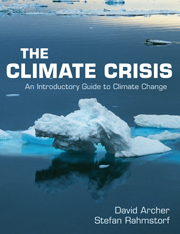Book contents
- Frontmatter
- Contents
- Preface
- 1 Retrospective: what we knew and when we knew it
- 2 Earth's energy budget
- 3 Climate change so far
- 4 Snow and ice
- 5 How the oceans are changing
- 6 The past is the key to the future
- 7 What the future holds
- 8 Impacts of climate change
- 9 Avoiding climate change
- 10 Climate policy
- Epilogue
- References
- Illustration credits
- Index
5 - How the oceans are changing
Published online by Cambridge University Press: 05 March 2013
- Frontmatter
- Contents
- Preface
- 1 Retrospective: what we knew and when we knew it
- 2 Earth's energy budget
- 3 Climate change so far
- 4 Snow and ice
- 5 How the oceans are changing
- 6 The past is the key to the future
- 7 What the future holds
- 8 Impacts of climate change
- 9 Avoiding climate change
- 10 Climate policy
- Epilogue
- References
- Illustration credits
- Index
Summary
The oceans are a major player in the climate system. They cover two-thirds of our planet – hence most of the energy from the sun, which drives the whole climate system, goes into the oceans first. Ocean water can store a large amount of heat. This heat storage capacity of the oceans is a thousand times larger than that of the atmosphere, and it causes what is sometimes called “thermal inertia”: the climate response lags behind the forcing (i.e., the drivers – the concept of forcing was explained in Chapter 2), as it takes time for the oceans to warm up. That has reduced the global warming seen thus far – and it makes us committed to more warming in future, even if greenhouse gas concentrations were stabilized today.
The oceans also move large amounts of heat around the world through ocean currents – this can have a big impact on regional climate, hence the interest in how ocean currents might be changing. The oceans are also the main source of water vapor for the atmosphere and thus for the precipitation falling on our planet. And the fish we take from the oceans have for millennia played an important role in human diet, with the quest for fish shaping many facets of our history. The oceans also turn out to be a major sink of the carbon dioxide that we are releasing into the atmosphere – we will discuss below how this is a blessing and a curse at the same time.
- Type
- Chapter
- Information
- The Climate CrisisAn Introductory Guide to Climate Change, pp. 86 - 104Publisher: Cambridge University PressPrint publication year: 2009



